-
Notifications
You must be signed in to change notification settings - Fork 53
Component: Measurements
Measurements are the basic Influxdb structure let us group series of the same type/origin.
When data are gathered from SNMP devices we can group them together as we wish when snmp data are scalar objects but is mandatory group snmp tabular objects in the same measurement.
Configured Measurements are shown as table. This will appear every time you navigate from menu.
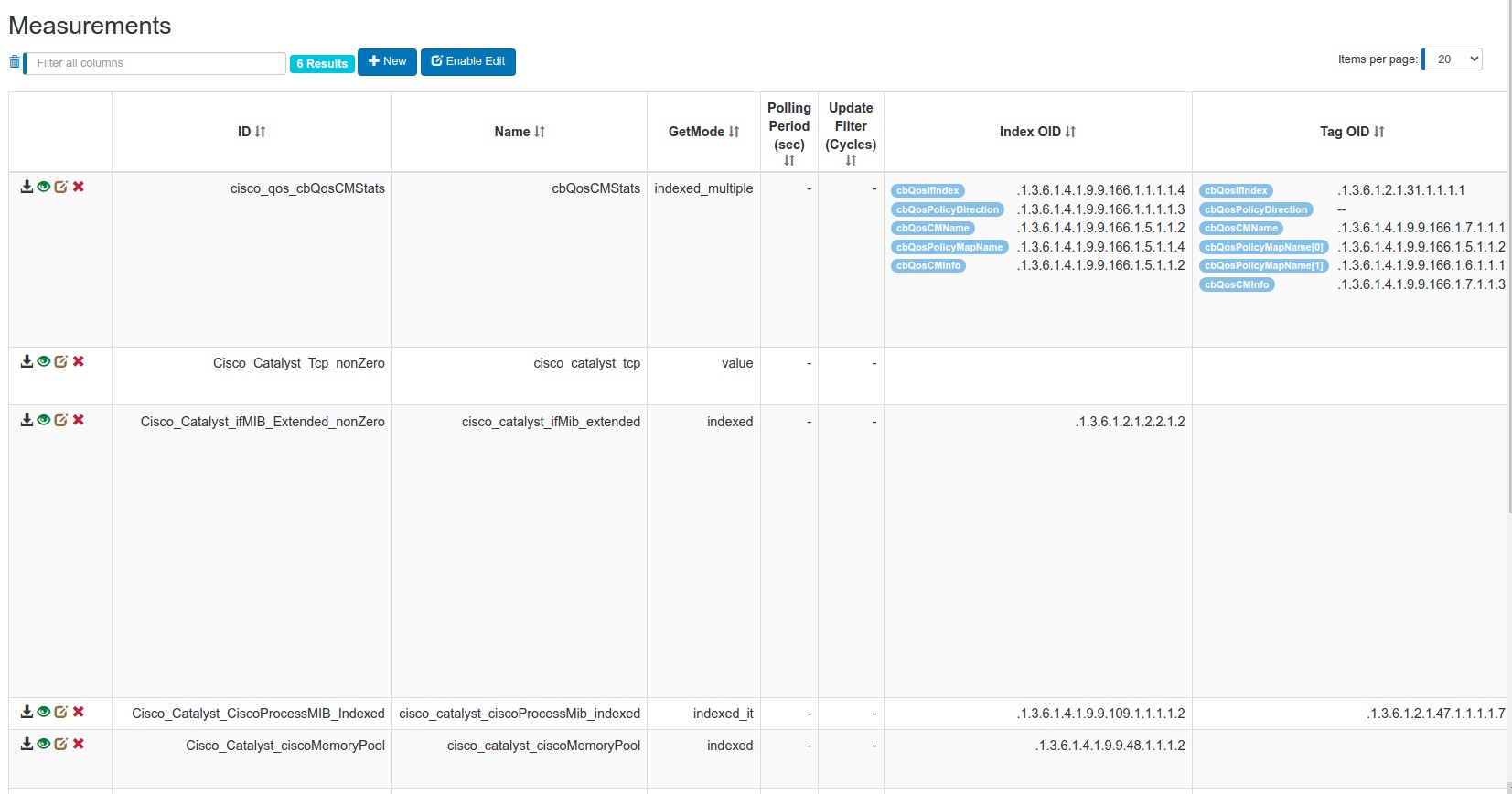
-
Add: In the Measurements list click on new button
-
Edit: Click on Measurement edit's button
The Create/Modify form will show up:
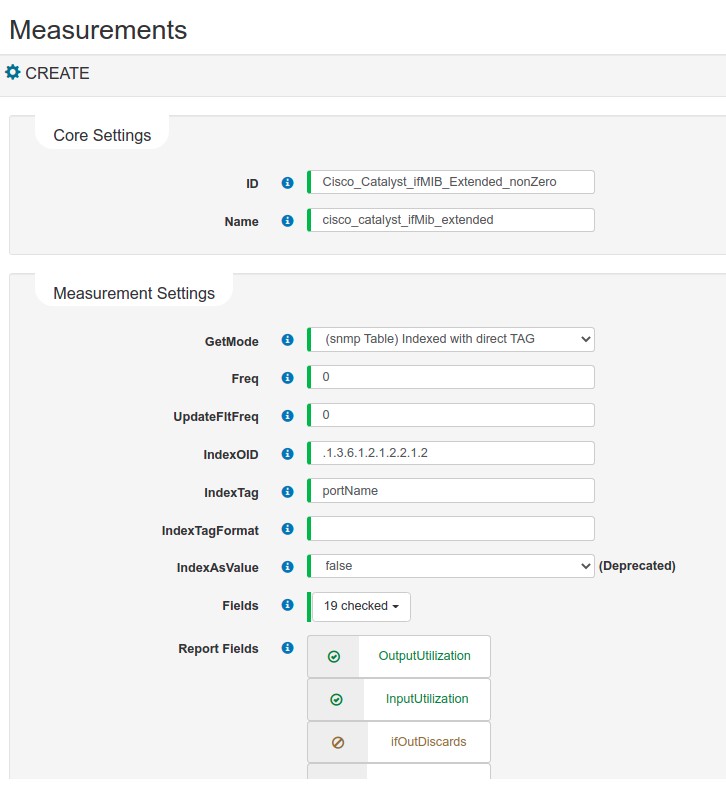
Multi edit has 2 options: Remove and Change property
-
Remove: Allows to remove all the selected items
-
Change property: Allows to change the selected property of all the selected items. The properties are the same defined in the configuration.
| Property | Type | Options/Values |
|---|---|---|
| IndexTag | Input | Tag Name (string) |
| IndexAsValue | Selector | True/False |
| Config Parameter | Description |
|---|---|
| ID | Text String that uniquely identify the measurement recommended use the MIB Name prefixed/suffixed with some other string data we can easily identify (as manufacturer or model) that will help us to look in the Measurement config section, should be unique in the database |
| Name | This will be the Measurement name created in the Database when sending data, will let us to query data with "SELECT * from ..." |
| Config Parameter | Description |
|---|---|
| GetMode | The behavior of a measurement and its related metrics is given by the field GetMode, How data are collected and organized depends on this parameter. |
| Freq | The gathering frequency for only this measurement in seconds. If not set the default device gathering frequency will be set [ only for > 0.12.0 release] |
| UpdateFilterFreq | Number pof complete polls that this measurement will wait before perform a snmp table index/filter update , the final update time will be (this MeasurementFreq)*Measurement-FilterUpdate ( in seconds) . If not set the device default filter frequency will be set [ only for > 0.12.0 release] |
The Value type measurement doesn't go over any OID and it won't generate any tag to identify its metrics
Only non-indexed metrics should be added
| Config Parameter | Description |
|---|---|
| Fields | A list of MetricID which will be part of this measurement and what to do with the value. On Value measurements only metrics that are not-indexed should be added |
| Report Fields | All metrics can be configured to be sent or not to the backend:
|
The Indexed with direct Tag measurement iterates over a table (IndexOID) and maps the index and result to be used as tags.
All attached metrics will be identified by that index, so all the metrics should be, or share, on the same table/index
| Config Parameter | Description |
|---|---|
| IndexOID | (only required for SNMP Table based data) The OID will be queried to get row Tag Values of the table. Only metrics that shares the same table/index should be added |
| IndexTag | (only required for SNMP Table based data) the tag name will be sent to distinguish among different rows |
| IndexTagFormat | (only required for SNMP Table based data) enable custom format for TAGS based on parameters from values and indexes from IndexOID (parameters as $IDX1 and $VAL1) Default format is $VAL1.example: [$IDX1]-$VAL1 will be sent as tag a "[1]-eth0 (see IndexTagFormat below for more detailed info)" |
| Fields | A list of MetricID which will be part of this measurement and what to do with the value. On Value measurements only metrics that are not-indexed should be added |
| Report Fields | All metrics can be configured to be sent or not to the backend:
|
Example of valid tables:
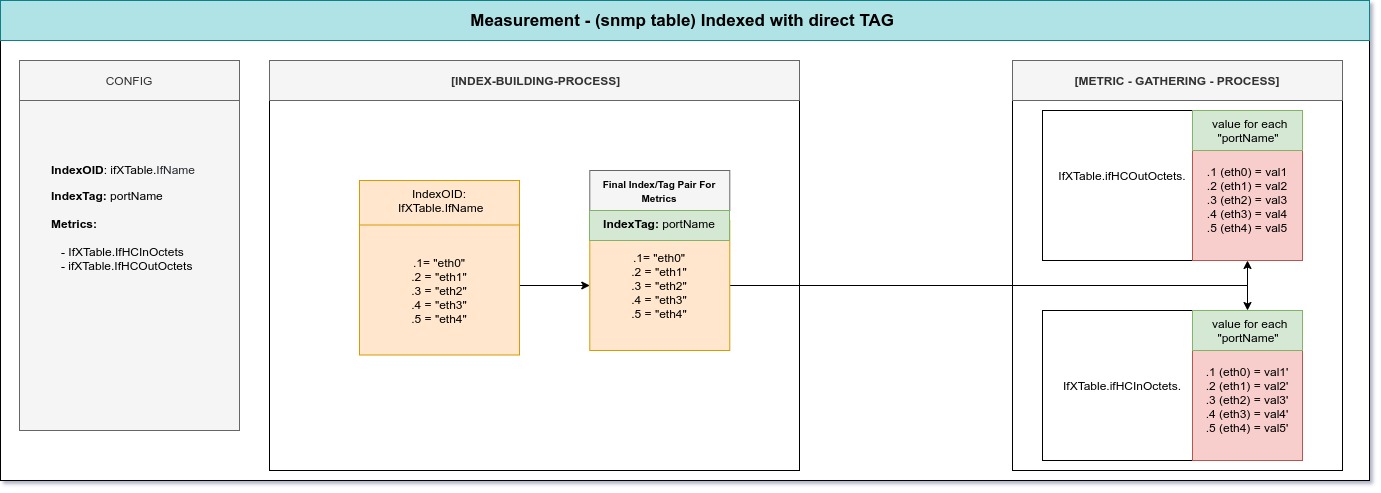
Measurement Config:
Index OID: ifXTable.IfName - 1.3.6.1.2.1.31.1.1.1.1
Index Process:
1.3.6.1.2.1.31.1.1.1.1[.1] = `eth0`
1.3.6.1.2.1.31.1.1.1.1[.2] = `eth1`
1.3.6.1.2.1.31.1.1.1.1[.3] = `eth2`
1.3.6.1.2.1.31.1.1.1.1[.4] = `eth3`
1.3.6.1.2.1.31.1.1.1.1[.5] = `eth4`
Metrics:
ifXTable.ifHCInOctets - 1.3.6.1.2.1.31.1.1.1.6
1.3.6.1.2.1.31.1.1.1.6.[1:eth0] = val1
1.3.6.1.2.1.31.1.1.1.6.[2:eth1] = val2
1.3.6.1.2.1.31.1.1.1.6.[3:eth2] = val3
1.3.6.1.2.1.31.1.1.1.6.[4:eth3] = val4
1.3.6.1.2.1.31.1.1.1.6.[5:eth4] = val5
ifXTable.ifHCInOctets - 1.3.6.1.2.1.31.1.1.1.10
1.3.6.1.2.1.31.1.1.1.10.[1:eth0] = val1'
1.3.6.1.2.1.31.1.1.1.10.[2:eth1] = val2'
1.3.6.1.2.1.31.1.1.1.10.[3:eth2] = val3'
1.3.6.1.2.1.31.1.1.1.10.[4:eth3] = val4'
1.3.6.1.2.1.31.1.1.1.10.[5:eth4] = val5'The Indexed with indirect TAG measurements iterates over a table that has as value the related index to retrieve the tag (an indirect index). The related table will be retrieved and used as tags.
All attached metrics will be identified by the IndexOID, so all the metrics should be, or share, on the same table/index
| Config Parameter | Description |
|---|---|
| IndexOID | (only required for SNMP Table based data) The OID will be queried to get row Tag Values of the table. Only metrics that shares the same table/index should be added |
| IndexTag | (only required for SNMP Table based data) the tag name will be sent to distinguish among different rows |
| TagOID | (only required for SNMP indirect Tag based data) the OID will be queried to get TAG value names from other table. |
| IndexTagFormat | (only required for SNMP Table based data) enable custom format for TAGS based on parameters from values and indexes from IndexOID ( parameters as $IDX1 and $VAL1) or TagOID when measurement is defined as indirect indexes defined ( parameters $IDX2 and $VAL2). Default format is $VAL2.example: [$IDX1]-$VAL1-$VAL2 will be sent as tag a [1]-4-eth0 (see IndexTagFormat below for more detailed info)" |
| Fields | A list of MetricID which will be part of this measurement and what to do with the value. On Value measurements only metrics that are not-indexed should be added |
| Report Fields | All metrics can be configured to be sent or not to the backend:
|
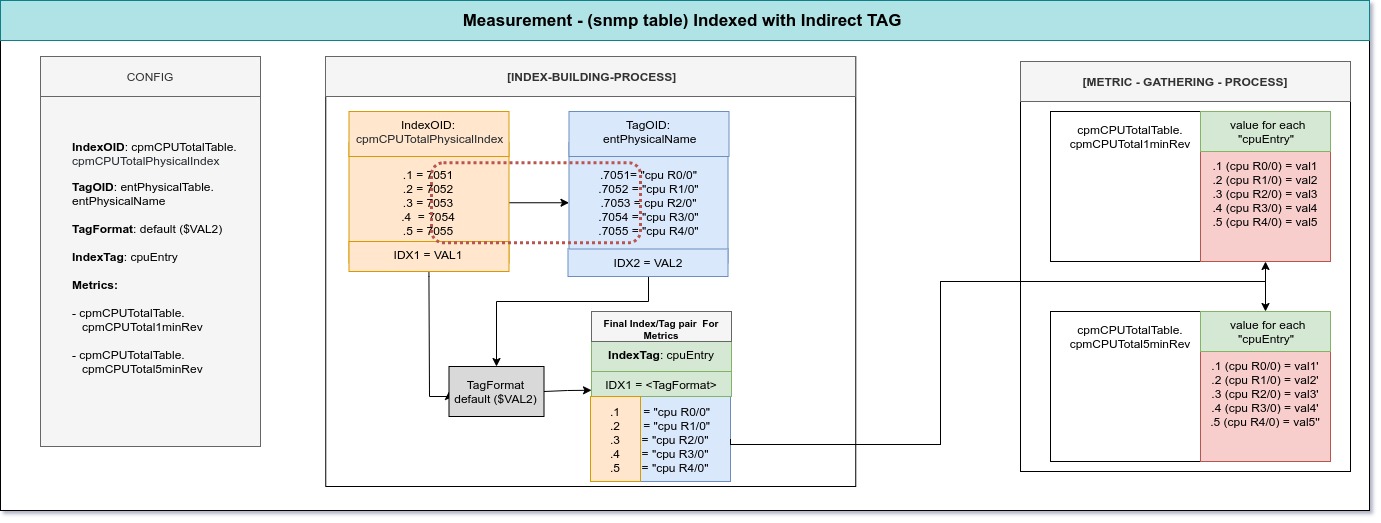
Example of valid tables:
Measurement Config:
IndexOID: cpmCPUTotalPhysicalIndex - 1.3.6.1.4.1.9.9.109.1.1.1.1.2
TagOID: entPhysicalTable.entPhysicalName - 1.3.6.1.2.1.47.1.1.1.1.7
Index Process:
Index OID:
1.3.6.1.4.1.9.9.109.1.1.1.1.2[.1] = `7051`
1.3.6.1.4.1.9.9.109.1.1.1.1.2[.2] = `7052`
1.3.6.1.4.1.9.9.109.1.1.1.1.2[.3] = `7053`
1.3.6.1.4.1.9.9.109.1.1.1.1.2[.4] = `7054`
1.3.6.1.4.1.9.9.109.1.1.1.1.2[.5] = `7055`
1.3.6.1.2.1.47.1.1.1.1.7[.7051] = `cpu R0/0`
1.3.6.1.2.1.47.1.1.1.1.7[.7052] = `cpu R1/0`
1.3.6.1.2.1.47.1.1.1.1.7[.7053] = `cpu R2/0`
1.3.6.1.2.1.47.1.1.1.1.7[.7054] = `cpu R3/0`
1.3.6.1.2.1.47.1.1.1.1.7[.7055] = `cpu R4/0`
Index result:
[.1:cpu R0/0]
[.2:cpu R1/0]
[.3:cpu R2/0]
[.4:cpu R3/0]
[.5:cpu R4/0]
Metrics:
cpmCPUTotalTable.cpmCPUTotal1minRev - .1.3.6.1.4.1.9.9.109.1.1.1.1.7
.1.3.6.1.4.1.9.9.109.1.1.1.1.7.[1:cpu R0/0] = val1
.1.3.6.1.4.1.9.9.109.1.1.1.1.7.[2:cpu R1/0] = val2
.1.3.6.1.4.1.9.9.109.1.1.1.1.7.[3:cpu R2/0] = val3
.1.3.6.1.4.1.9.9.109.1.1.1.1.7.[4:cpu R3/0] = val4
.1.3.6.1.4.1.9.9.109.1.1.1.1.7.[5:cpu R4/0] = val5
cpmCPUTotalTable.cpmCPUTotal5minRev - .1.3.6.1.4.1.9.9.109.1.1.1.1.8
.1.3.6.1.4.1.9.9.109.1.1.1.1.8.[1:cpu R0/0] = val1'
.1.3.6.1.4.1.9.9.109.1.1.1.1.8.[2:cpu R1/0] = val2'
.1.3.6.1.4.1.9.9.109.1.1.1.1.8.[3:cpu R2/0] = val3'
.1.3.6.1.4.1.9.9.109.1.1.1.1.8.[4:cpu R3/0] = val4'
.1.3.6.1.4.1.9.9.109.1.1.1.1.8.[5:cpu R4/0] = val5'The Indexed with multiple indirect TAG measurements iterates N times over different tables to be retrieving the values that relates those tables until the tag is retrieved. The final related table will be retrieved and used as tags.
All attached metrics will be identified by the IndexOID, so all the metrics should be, or share, on the same table/index
| Config Parameter | Description |
|---|---|
| IndexOID | (only required for SNMP Table based data) The OID will be queried to get row Tag Values of the table. Only metrics that shares the same table/index should be added. The final index will contain the first queried indexes of the table |
| IndexTag | (only required for SNMP Table based data) the tag name will be sent to distinguish among different rows |
| Multiple TagOID | The multiples OIDs in order that will be queried to retrieve the tag value. The value will be extracted and formatted from the last queried table. Each MultipleTagOID has:
|
| IndexTagFormat | (only required for SNMP Table based data) enable custom format for TAGS based on parameters from values and indexes from IndexOID ( parameters as $IDX1 and $VAL1) or TagOID when measurement is defined as indirect indexes defined ( parameters $IDX2 and $VAL2). Default format is $VAL2.example: [$IDX1]-$VAL1-$VAL2 will be sent as tag a [1]-4-eth0 (see IndexTagFormat below for more detailed info)" |
| Fields | A list of MetricID which will be part of this measurement and what to do with the value. On Value measurements only metrics that are not-indexed should be added |
| Report Fields | All metrics can be configured to be sent or not to the backend:
|
Mutiple TagOID manipulation
Use the following button to add a new TagOID 
The following buttons allow to reorder and delete defined TagOIDs:
- Remove:

- Promote:

- Demote:


Example of valid tables:
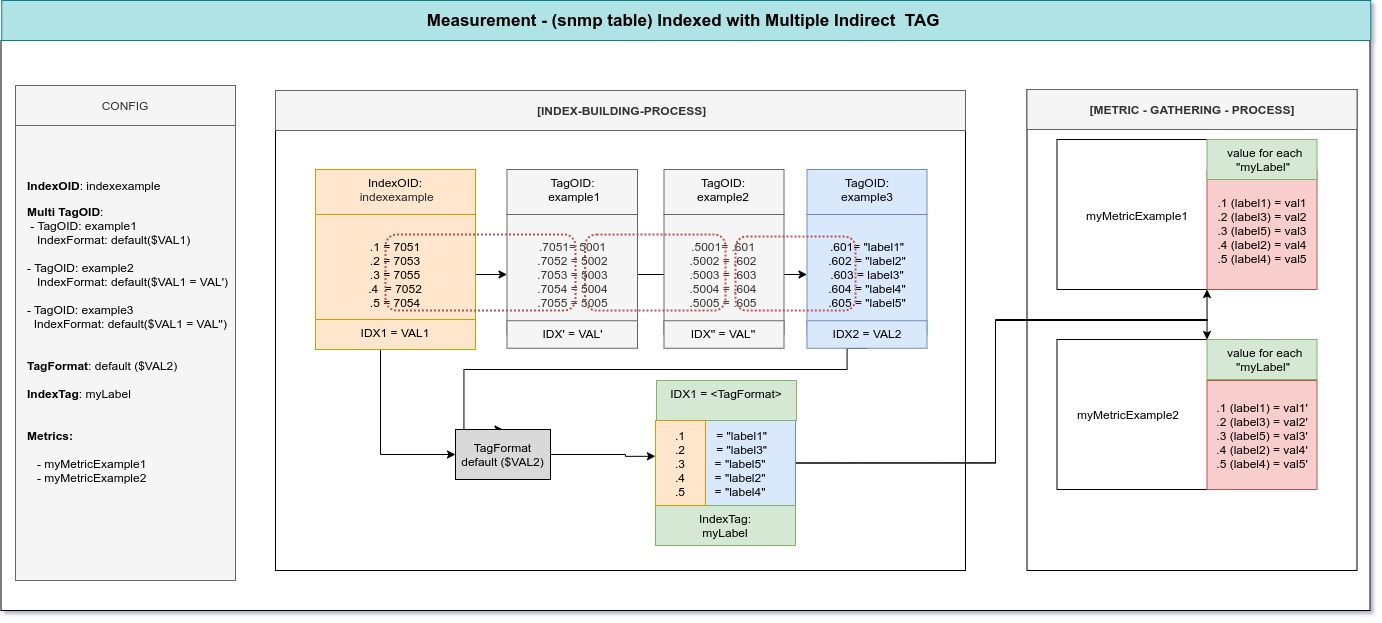
Measurement Config:
IndexOID: indexedExample - 1.2.3.5.1
MultiTagOID
0: - TagOID: example1 - 1.2.3.6.1
- IndexFormat: ""
1: - TagOID: example2 - 1.2.3.7.1
- IndexFormat: ""
2: - TagOID: example3 - 1.2.3.8.1
- IndexFormat: ""
Index Process:
IndexOID - indexExample:
1.2.3.5.1[.1] = `7051`
1.2.3.5.1[.2] = `7052`
1.2.3.5.1[.3] = `7053`
1.2.3.5.1[.1] = `7054`
1.2.3.5.1[.2] = `7055`
TagOID 0 - example1
1.2.3.6.1[.7051] = `5001`
1.2.3.6.1[.7052] = `5002`
1.2.3.6.1[.7053] = `5003`
1.2.3.6.1[.7054] = `5004`
1.2.3.6.1[.7055] = `5005`
TagOID 1 - example2
1.2.3.7.1[.5001] = `601`
1.2.3.7.1[.5002] = `602`
1.2.3.7.1[.5003] = `603`
1.2.3.7.1[.5004] = `604`
1.2.3.7.1[.5005] = `605`
TagOID 2 - example3
1.2.3.8.1[.601] = `label0`
1.2.3.8.1[.602] = `label1`
1.2.3.8.1[.603] = `label2`
1.2.3.8.1[.604] = `label3`
1.2.3.8.1[.605] = `label4`
Index result:
[.1:label1]
[.2:label2]
[.3:label3]
[.4:label4]
[.5:label5]
Metric:
myMetricExample - 1.2.3.10.1
1.2.3.10.1.[1:label1] = val1
1.2.3.10.1.[2:label2] = val2
1.2.3.10.1.[3:label3] = val3
1.2.3.10.1.[4:label4] = val4
1.2.3.10.1.[5:label5] = val5
myMetricExample - 1.2.3.10.2
1.2.3.10.1.[1:label1] = val1'
1.2.3.10.1.[2:label2] = val2'
1.2.3.10.1.[3:label3] = val3'
1.2.3.10.1.[4:label4] = val4'
1.2.3.10.1.[5:label5] = val5'The multiple indexes measurement allows the user to define different internal measurements that will create the map of index/value and can have dependencies to share its information between them To see an example go to examples section
| Config Parameter | Description |
|---|---|
| Multi Index Measurements | The array of indexes measurements (direct, indirect and multi indirect) to create a complex index with tags embebbed |
| Result | Custom final index that will be used to match fields OIDs. The syntax is explained on section below |
Each Multi Index Measurement can be identified by its index (position in array)
The options available on the Multi Index Measurements are the same as defined above, depending of the type (GetMode) and the added one.
| Config Parameter | Description |
|---|---|
| Index Label | The internal name of the index |
| Index Description | The internal description of the index |
| Index Dependency | The dependency syntax to heridate tags from other index based on the following syntax: `IDX{};DOT[NN:MM];FILL(XXX) |
Mutiple Index manipulation
Select the type of Index to add a new one, click on the following button to add a index  .
Available indexes are:
.
Available indexes are:
- (snmp Table) Indexed with direct TAG - indexed
- (snmp Table) Indexed with indirect TAG - indexed_it
- (snmp Table) Indexed with multi indirect tag - indexed_mit

The following buttons allow to reorder and delete defined Multi Indexes:
- Remove:

- Promote:

- Demote:


Multi Indexes allows the user to define several internal measurements to retrieve different tags and identifies and build a custom index to use it on metrics
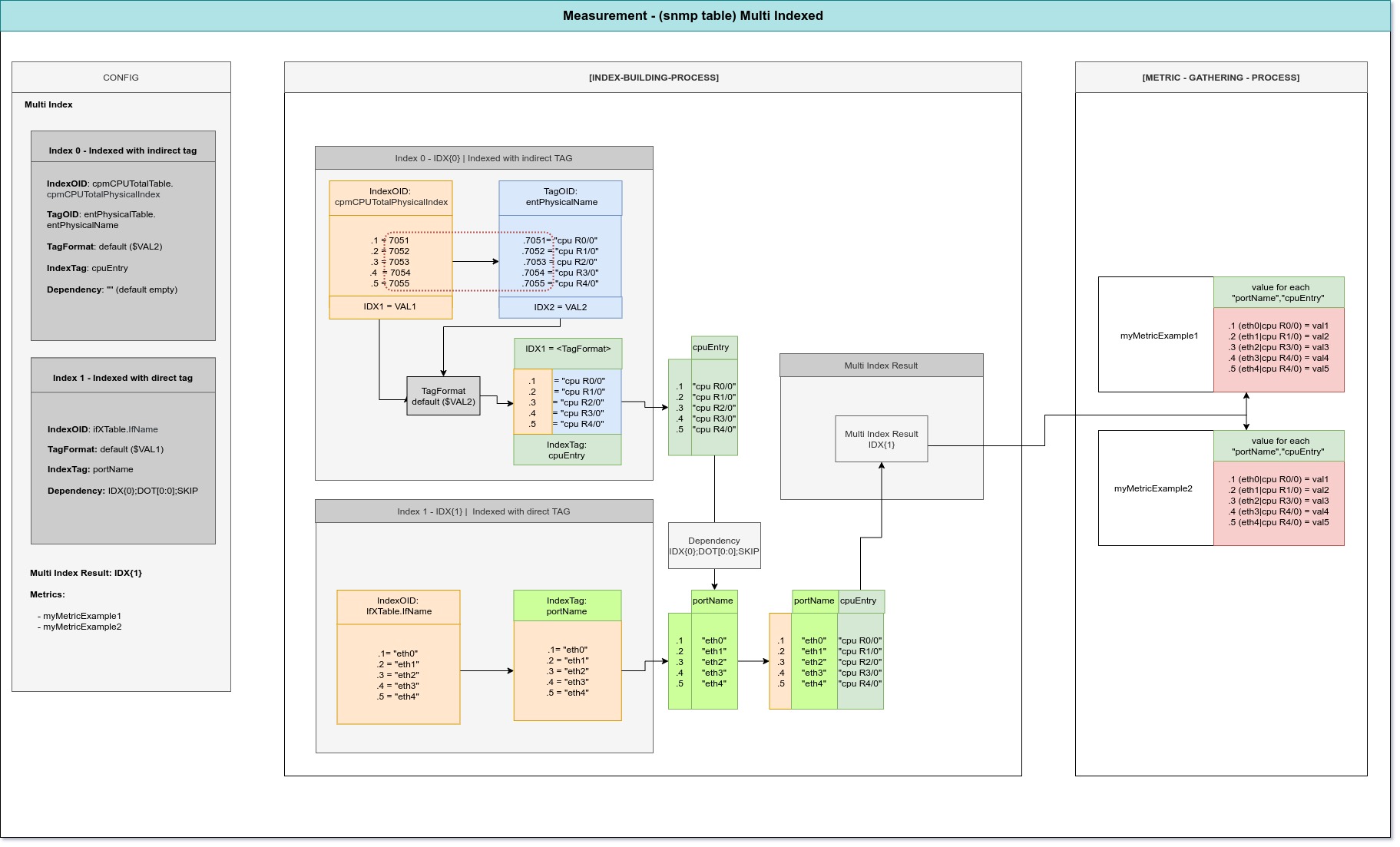
Dependency
The dependency system between indexes allows the index to heridate already retrieved tags from other indexes and attach them to the current one The syntax follows as:
IDX{IM};DOT[XX:YY];SKIP
If the user defines only IDX{IM}, a FILL("") strategy will be applied with an entire index match
The IDX{IM} references to another index, based on its position of the array. Example:
Index 0 | [.1] = "eth0"
|
| Index Tag = portName
--------
Index 1 | [.1] = up
|
| Index Tag = "ifStatus"
| Dependency IDX{0}
| --> [.1] = "up|eht0" [ifStatus, portName]The DOT[XX:YY] allows to change the check option to heridate tags from another index, this is useful if the tables doesn't have the same dimension, but it shares a common index. Example:
Index 0 | [.1] = "eth0"
|
| Index Tag = "portName"
--------
Index 1 | [.1.2] = up
|
| Index Tag = "ifStatus"
| Dependency IDX{0};DOT[0:0];FILL()
| --> [1.1] = "up|eht0" [ifStatus, portName]The FILL(XX)|SKIP section defines the strategy of non match index:
- The
FILL(XX)allows the user to define a custom tag value (XXX) if the dependency index has no the current index on it. - The
SKIPdeletes the current point if it doesn't match with the current index
Index 0 | [.1] = "eth0"
---------
Index 1 | [.1.1] = "up"
| [.2.1] = "down"
|
| Dependency: IDX{0};DOT[0:0];FILL(no value present)
| --> [1.1] = "up|eth0" [ifStatus, portName]
| --> [2.1] = "down|no value present"Index 0 | [.1] = "eth0"
---------
Index 1 | [.1.1] = "up"
| [.2.1] = "down"
|
| Index Tag = "ifStatus"
| Dependency: IDX{0};DOT[0:0];SKIP
| --> [1.1] = "up|eth0" [ifStatus, portName]
| < DELETED [2.1]>
Result
The result allows the user to create a totally custom index to be set up with attached fields. The syntax follows as:
IDX{IM};DOT[XX:YY]].<number>.<IDX{IM};DOT[XX:YY]>.<...>If several IDX{IM} are found, it will create a big index using the scalar product between them heridating its tags
Index 0 | [.1] = "eth0"
| [.2] = "eth1"
| <No dependency configured>
---------
Index 1 | [.3] = "up"
| [.4] = "down"
| <No dependency configured>Result: IDX{0}.IDX{1}
Final Index | [.1.3] = "eth0 | up"
| [.1.4] = "eth0 | down"
| [.2.3] = "eth1 | up"
| [.2.4] = "eth1 | down"Result: .35.IDX{0}:
Final Index | [.35.1] = "eth0"
| [.35.1] = "eth0"Result: .35.IDX{1}.42:
Final Index | [.35.3.42] = "up"
| [.35.3.42] = "down"Enable user define a custom format for TAGS based on parameters from values and indexes from IndexOID or TagOID when measurement is defined as indirect indexes defined
Current variable inputs are only IDX1,VAL1 for direct indexed measurements and also IDX2,VAL2 when indirect indexed measurements.
To refer to these variables you could prepend a '$' to the variable name. If not definition exist,default format will be $VAL1 for direct indexed tables and $VAL2 for indirect indexed.
User can also take parts of each variable and apply transformation to get desired tag name by only use the following syntax
${VAR|SELECTOR|TRANSFORMATOR}
- VAR : the variable source, could be referenced several times in the same definition
- SELECTOR: (by default the complete variable string) will select a bit of the VARIABLE, could be void string and the default value will be selected
- TRANSFORMATOR (by default STRING) will apply a transformation on the previously selected bit of variable, could be void string and the default value will be selected
- ALL: complete string
- DOT[X:Y] : splits variable in an array of numbers and select only from the Xth to the Yth value, if X is omitted 0 will be chosen , if Y is omitted the last element on the splitted array will be chosen , in this mode DOT[0:] is equivalent to ALL. Counter always begins from 0 and both X and Y position will be included in the final selection
- REGEX/regex-expression/substitution-expression/: (since 0.7.3) Regex based Substitution pattern , each section is described in the following table
| regex section | meaning |
|---|---|
| regex-expresion | could be any valid golang based regular expressions. These regular expressions should have defined capturing groups Limitation: we can not use the "|" character because of this character would alter the ${VAR|SELECTOR|TRANSFORMATOR} struct. ( In the future would should improve syntax to avoid this limitation). |
| substitution-expression | any string containing valid back references ie "\1, \2, \3, ..... etc", for previously defined capturing groups |
- STRING : return the selected value as an string
- DEC2ASCII: decode a dotted separated string with numbers as ascii bytes of a string ("100.101.102.97.117.108.116" will be "default")
-
MAC: decode a string as MAC address.( .1.3.6.1.2.1.10.127.1.3.3.1.2.89 = STRING: 60:2a:d0:40:42:1a ) will be decoded as MAC with this format
:${VAL1|DOT[0:]|MAC}(>version 0.10)
We can use inetCidrRouteIfIndex as example: The following is the output from one row of the table with "snmpwalk".
IP-FORWARD-MIB::inetCidrRouteIfIndex.ipv4."0.0.0.0".0.2.0.0.ipv4."10.0.2.2" = INTEGER: 2equivalent to that.(I've separated baseOID from Index)
BaseOID[1.3.6.1.2.1.4.24.7.1.7]+ INDEX[.1.4.0.0.0.0.0.2.0.0.1.4.10.0.2.2] = INTEGER: 2when looking for index info here inetCidrRouteEntry (http://oid-info.com/get/1.3.6.1.2.1.4.24.7.1), we have found the following
INDEX {
inetCidrRouteDestType, ipv4(1), ipv6(2), ipv4z(3), ipv6z(4)) = 1
inetCidrRouteDest, = 4 - 0.0.0.0
inetCidrRoutePfxLen, = 0.2
inetCidrRoutePolicy, = 0.0
inetCidrRouteNextHopType = 1
inetCidrRouteNextHop = 4 -> 10.0.2.2
}
````bash
In this case we would like by example take RouteDest and RouteNextHop as IndexTAG with
```bash
${IDX1|DOT[2:5]|STRING} -> ${IDX1|DOT[12:15]|STRING}this will equivalent to
${IDX1|DOT[2:5]|} -> ${IDX1|DOT[12:15]|}And the output result will be
0.0.0.0 -> 10.0.2.2Lets assume that we want to retrieve the following values of the following metrics
The base OID from those are 1.1 and they have a double index, [X,Y] which gives us the following information:
X=related interface
Y=related objectmyMetricTable: 1.1 [X,Y]
1.1[.1.1] | 51
1.1[.2.1] | 52
1.1[.3.1] | 53
1.1[.4.1] | 54
1.3[.1.1] | 21
1.3[.2.1] | 22
1.3[.3.1] | 23
1.3[.4.1] | 24To identify those metrics, we need to retrieve the tag value on myFinalRealTagTable - 1.5, but we need a double index iteration to retrieve the desired tag and it is indexed by M.
The process would be:
1.2.[X.Y] --> [Z] --> 1.10.[X.Z] --> [M] --> 1.5.[M] --> tagmyIndexTagTable: .1.2[X.Y] | [Z]
.1.2.[1.1] | 2
.1.2.[2.1] | 2
.1.2.[3.1] | 2
.1.2.[4.1] | 2
---
myRealTagTable: .1.10.[X.Z] | [M]
.1.10.1.2 | 90
.1.10.2.2 | 91
.1.10.3.2 | 92
.1.10.4.2 | 93
---
myFinalRealTagTable: .1.5.[M] | [TagValue]
.1.5.94 | "eth1"
.1.5.95 | "eth2"
.1.5.96 | "eth3"
.1.5.97 | "eth4"As we can see we need to go over 3 different tables and different indexes to retrieve values that can identify each value of pair [X.Y]. To achieve that, we create the following measuement:
As we need to match with the metrics, we need to go over myIndexTagTable to retrieve and store indexes [X.Y], so we configure the IndexOID as 1.2. The output of this table will be used as the next one:
Def:
IndexOID: "1.2" | [X.Y]
Result: "2, 2, 2, 2 | [Z]To retrieve the second table, we cannot use the value given Z becouse we need also the var X in order to match the index. As the X is present on table myIndexTagTable and myRealTagTable, we can format the index to achieve the desired [X.Z]
Def:
TagOID: ".1.10",
IndexFormat: "${IDX1|DOT[0:0]|STRING}.$VAL1" --> [X.Z]
Result: "90, 91, 92, 93"With the matched value of M, we can retrieve the final table, in this case, we don't need to setup a format as the required index is directly indexed by [M]
Def:
TagOID: ".1.5",
IndexFormat: ""
Result: "eth1, eth2, eth3, eth4"On this point, we will have map that relates our initial [X.Y] to our desired tags Remember that on multiple inderect measurement, the final index is equal than the IndexOID to be equal than the metrics
1.1 | eth1
1.2 | eth2
1.3 | eth3
1.4 | eth4All the metric of IfMIB are based on IfIndex OID: 1.3.6.1.2.1.2.2.1.1. According to its description:
A unique value for each interface. Its value ranges between 1 and the value of ifNumber. The value for each interface must remain constant at least from one re-initialization of the entity's network management system to the next re-initialization.
As all related metrics shares the same index, we can define a simple Direct Index measurement to retrieve those metrics, but, for this case, metrics that are constants, like tags, doesn't need to be polled every frequency, it can be gathered on filter freq.
On this example, we will use the following metrics that are, in some way, static for each interface:
| Name | OID |
|---|---|
| ifDesc | .1.3.6.1.2.1.2.2.1.2 |
| ifName | .1.3.6.1.2.1.31.1.1.1.1 |
| ifAlias | .1.3.6.1.2.1.31.1.1.1.18 |
The related fields that we want to gather are defined as SNMP Metrics:
| ID | FieldName | BaseOID | DataSrcType |
|---|---|---|---|
| ifHCInOctets | ifHCInOctets | .1.3.6.1.2.1.31.1.1.1.6 | COUNTER64 |
| ifHCOutOctets | ifHCOutOctets | .1.3.6.1.2.1.31.1.1.1.10 | COUNTER64 |
A simple walk over those metrics gives us the follow index/value:
ifHCInOctets >
.1.3.6.1.2.1.31.1.1.1.6[.1] | 3
.1.3.6.1.2.1.31.1.1.1.6[.2] | 4
.1.3.6.1.2.1.31.1.1.1.6[.3]| 20
ifHCOutOctets >
.1.3.6.1.2.1.31.1.1.1.6[.1] | 5
.1.3.6.1.2.1.31.1.1.1.6[.2] | 7
.1.3.6.1.2.1.31.1.1.1.6[.3]| 35In order to identify those metrics with ifAlias, ifName, ifDesc tags, we create a create a Multi Index Measurement,with 3 different indexes. As the indexes don't need to be ordered we will define it in a non-logic order
| Index | Type | Label | Index Description | Index Base OID | Index Tag | Index Tag Format | Index Dependency |
|---|---|---|---|---|---|---|---|
| 0 | Indexed with direct Tag | ifName | Index to retrieve ifName tag | .1.3.6.1.2.1.31.1.1.1.1 | ifName | -- | "" |
| 1 | Indexed with direct Tag | ifDesc | Index to retrieve ifDesc | .1.3.6.1.2.1.2.2.1.2 | ifDesc | -- | IDX{2};DOT[0:0];SKIP (note that it references with an index that is greater than the current one. Remember that the order is not needed) |
| 2 | Indexed with direct Tag | ifAlias | Index to retrieve ifAlias | .1.3.6.1.2.1.31.1.1.1.18 | ifAlias | -- | IDX{0};DOT[0:0];SKIP |
As each index refers to a single measurement and it has its own lifecycle, the Dependency is used only to create the final result. In this case, we want to retrieve the final tags from IDX{1} (it will heridate the IDX{2} and IDX{0}) so:
Result: "IDX{1}"Example of measurement definition:
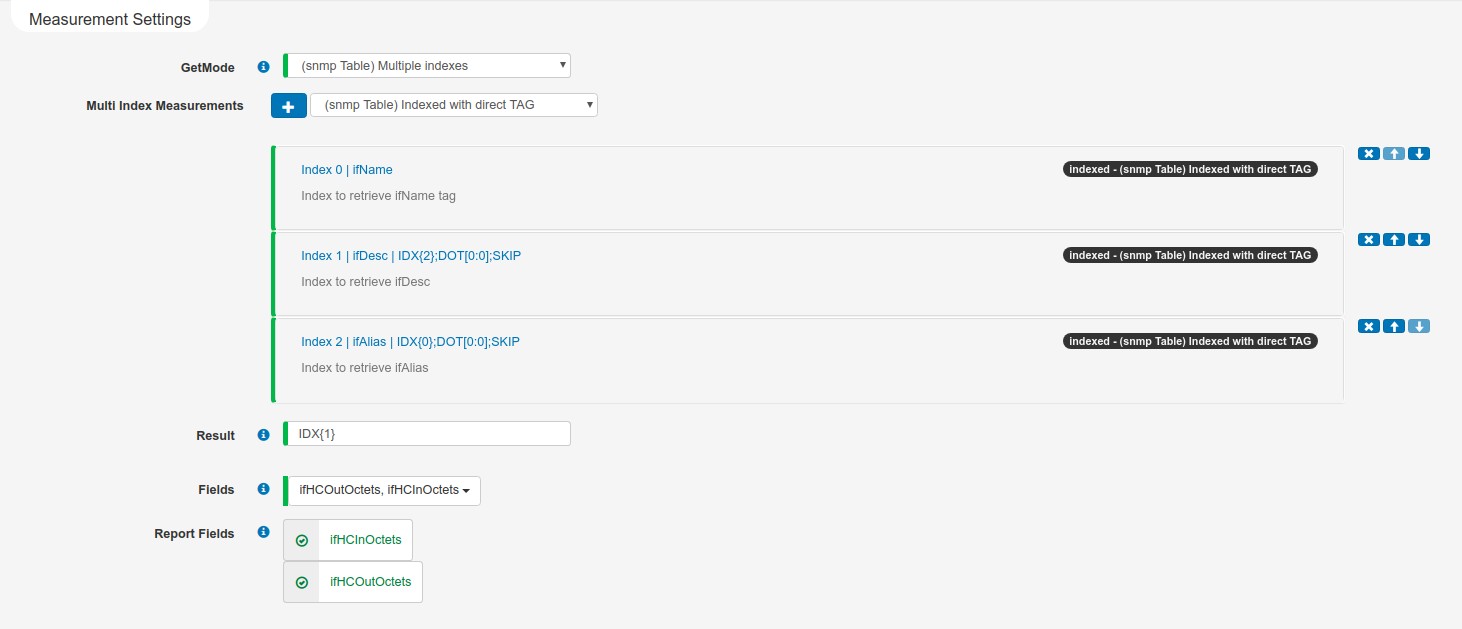
Each index will save on its own structure the gathered data based on its definition:
Index 0 | ifName >
.1.3.6.1.2.1.31.1.1.1.1[.1] | "Te1/0/1" || ifName
.1.3.6.1.2.1.31.1.1.1.1[.2] | "Te1/0/2" || ifName
.1.3.6.1.2.1.31.1.1.1.1[.3]| "Te1/0/3" || ifName
Index 1 | ifDesc >
.1.3.6.1.2.1.2.2.1.2[.1] | "TenGigabitEthernet1/0/1" || ifDesc
.1.3.6.1.2.1.2.2.1.2[.2] | "TenGigabitEthernet1/0/2" || ifDesc
.1.3.6.1.2.1.2.2.1.2[.3]| "TenGigabitEthernet1/0/3" || ifDesc
Index 2 | ifAlias >
.1.3.6.1.2.1.31.1.1.1.18[.1] | "To home" || ifAlias
.1.3.6.1.2.1.31.1.1.1.18[.2] | "-- <null, not defined!>" || ifAlias
.1.3.6.1.2.1.31.1.1.1.18[.3]| "To shop" || ifAlias
When building the result, all the measurements will be ordered based on dependencies, so, it will processed on the following order:
0| Index 0 | ifName | Not dependency
1| Index 2 | ifAlias | Dependency on Index 0
2| Index 1 | ifDesc | Dependency on old Index 2The building index schema follows as:
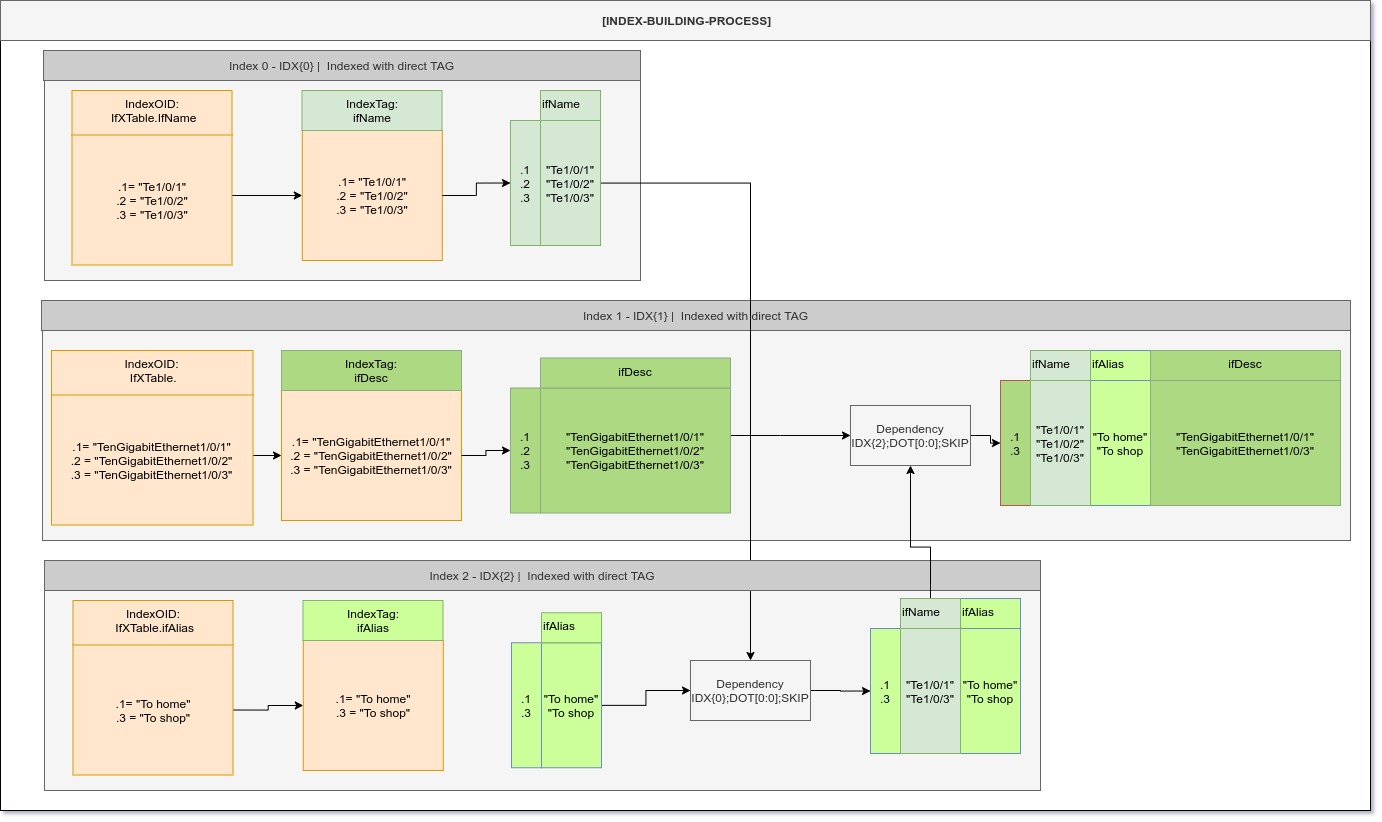
When a dependency exist, it tries to heridate the tags that matches the current OID. If it doesn't match, it applies the strategy, in this case SKIP
Index 2 | ifAlias - IDX{0};DOT[0:0];SKIP >
.1.3.6.1.2.1.31.1.1.1.18[.1] | "Tel1/0/1|To home" || ifName, ifAlias
.1.3.6.1.2.1.31.1.1.1.18[.3]| "Te1/0/3|To shop" || ifName, ifAlias
---
index [.2] it has been skipped due it doesn't exist on ifAlias and it will be skippedThe Index 2 dependency will use the new Index 1:
Index 1 | ifDesc - IDX{2};DOT[0:0];SKIP
.1.3.6.1.2.1.2.2.1.2[.1] | "Tel1/0/1|To home|TenGigabitEthernet1/0/1"
.1.3.6.1.2.1.2.2.1.2[.3]| "Te1/0/3|To shop|TenGigabitEthernet1/0/3"
---
index [.2] it has been skipped due it doesn't exist on processed Index 1 and it will be skippedThe result (IDX{1}) will be directly the Index 1- ifAlias with the new heridated tags:
.1.3.6.1.2.1.2.2.1.2[.1] | "Tel1/0/1|To home|TenGigabitEthernet1/0/1" || ifName | ifAlias | ifDesc
.1.3.6.1.2.1.2.2.1.2[.3]| "Te1/0/3|To shop|TenGigabitEthernet1/0/3" || ifName | ifAlias | ifDescSo, the final gathered metrics will be:
ifHCInOctets >
.1.3.6.1.2.1.31.1.1.1.6[.1] | 3 || ifName="Tel1/0/1",ifAlias="To home",ifDesc="TenGigabitEthernet1/0/1"
.1.3.6.1.2.1.31.1.1.1.6[.3]| 20 || ifName="Te1/0/3",ifAlias="To shop",ifDesc="TenGigabitEthernet1/0/3"
ifHCOutOctets >
.1.3.6.1.2.1.31.1.1.1.6[.1] | 5 || ifName="Tel1/0/1",ifAlias="To home",ifDesc="TenGigabitEthernet1/0/1"
.1.3.6.1.2.1.31.1.1.1.6[.3]| 35 || ifName="Te1/0/3",ifAlias="To shop",ifDesc="TenGigabitEthernet1/0/3"